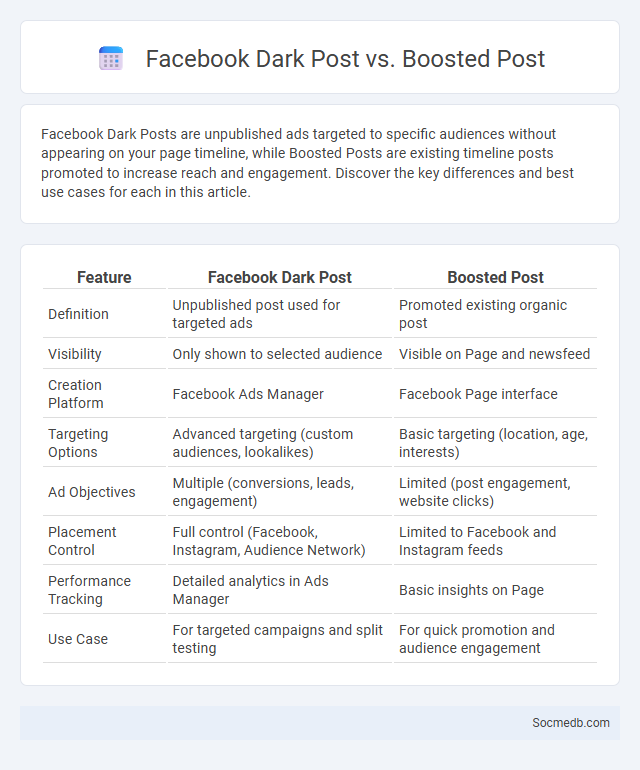
Photo illustration: Facebook Dark Post vs Boosted Post
Facebook Dark Posts are unpublished ads targeted to specific audiences without appearing on your page timeline, while Boosted Posts are existing timeline posts promoted to increase reach and engagement. Discover the key differences and best use cases for each in this article.
Table of Comparison
| Feature | Facebook Dark Post | Boosted Post |
|---|---|---|
| Definition | Unpublished post used for targeted ads | Promoted existing organic post |
| Visibility | Only shown to selected audience | Visible on Page and newsfeed |
| Creation Platform | Facebook Ads Manager | Facebook Page interface |
| Targeting Options | Advanced targeting (custom audiences, lookalikes) | Basic targeting (location, age, interests) |
| Ad Objectives | Multiple (conversions, leads, engagement) | Limited (post engagement, website clicks) |
| Placement Control | Full control (Facebook, Instagram, Audience Network) | Limited to Facebook and Instagram feeds |
| Performance Tracking | Detailed analytics in Ads Manager | Basic insights on Page |
| Use Case | For targeted campaigns and split testing | For quick promotion and audience engagement |
Understanding Facebook Dark Posts
Facebook Dark Posts are unpublished ads that appear only to targeted audiences, allowing precise control over your campaign reach without cluttering your public page. By using these hidden boosts, you can tailor content to specific demographics, locations, or interests, maximizing engagement and conversion rates. Mastering Facebook Dark Posts empowers your marketing strategy with highly customized and efficient ad delivery.
What Are Boosted Posts on Facebook?
Boosted posts on Facebook are paid advertisements that increase the reach of your regular posts to a broader audience beyond your current followers. By boosting a post, you target specific demographics like age, location, and interests, enhancing visibility and engagement through likes, comments, and shares. You can easily create boosted posts directly from your Facebook page to drive traffic, promote events, or increase brand awareness efficiently.
Key Differences Between Dark Posts and Boosted Posts
Dark posts are unpublished social media ads targeted to specific audiences without appearing on your main timeline, allowing precise segmentation and testing. Boosted posts, by contrast, are existing organic posts promoted to increase visibility and engagement across your followers and their networks. Choosing between dark posts and boosted posts depends on your marketing objectives, such as driving conversions with tailored messaging or amplifying organic content reach.
Advantages of Using Facebook Dark Posts
Facebook Dark Posts provide targeted advertising by allowing marketers to create unpublished posts that are shown only to specific audience segments, improving ad relevance and engagement. These posts enable A/B testing without cluttering the main Facebook page, optimizing campaign performance through precise data-driven adjustments. Enhanced control over audience reach and budget allocation makes Dark Posts a powerful tool for maximizing return on ad spend in social media marketing.
When to Choose Boosted Posts Over Dark Posts
Choosing boosted posts over dark posts is ideal when you want to increase the visibility of content to your existing followers and their networks with minimal setup. Boosted posts provide quick, simplified advertising directly from your social media page, making it easier for you to engage your audience without complex targeting strategies. Your best results come when you aim for enhanced engagement and brand awareness among a broad, familiar audience.
Step-by-Step Guide to Creating Facebook Dark Posts
Creating Facebook Dark Posts involves accessing Facebook Ads Manager, selecting the "Create" button, and choosing the "Create Ad" option without publishing to your page's timeline. Target audiences can be finely tuned using demographic, interest, and behavior parameters to enhance ad relevance. Utilize dark posts to test multiple creatives and messages, measuring performance through Facebook Ads Manager insights for optimized campaign results.
Best Practices for Facebook Boosted Posts
Optimizing Facebook Boosted Posts requires targeting the right audience through detailed demographic and interest-based filters to maximize engagement and conversion rates. Employing high-quality visuals, concise copy, and clear call-to-action buttons significantly improves click-through and interaction metrics. Monitoring key performance indicators such as reach, click-through rate (CTR), and cost per result enables effective budget allocation and real-time campaign adjustments.
Targeting and Customization in Dark Posts vs Boosted Posts
Dark posts enable precise targeting by allowing advertisers to create tailored, unpublished content that appears only to specific audience segments, maximizing relevance and engagement. Boosted posts offer broader customization by promoting existing organic content but provide less granular targeting compared to dark posts. Understanding these differences helps you optimize your social media strategy for better ROI through effective audience segmentation and personalized messaging.
Performance Metrics: Measuring Dark Posts vs Boosted Posts
Performance metrics for dark posts focus on tracking engagement and conversion rates within targeted audiences without public visibility, making it easier to measure precise impact through CTR, CPC, and ROI. Boosted posts show metrics such as reach, impressions, likes, comments, and shares since they are visible on your timeline, offering insight into overall brand engagement. Understanding these differences helps you optimize your social media advertising strategy by choosing the right type of post to achieve specific campaign goals.
Choosing the Right Strategy for Your Facebook Campaign
Selecting the right strategy for your Facebook campaign involves identifying your target audience based on demographics, interests, and behaviors to maximize engagement and conversion rates. Utilizing Facebook's detailed analytics and A/B testing ad variations helps optimize budget allocation and improves ad performance. Clear campaign objectives such as brand awareness, lead generation, or sales are essential to tailor creatives and messaging effectively, ensuring measurable ROI.
 socmedb.com
socmedb.com